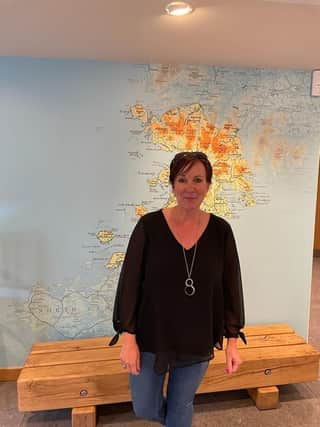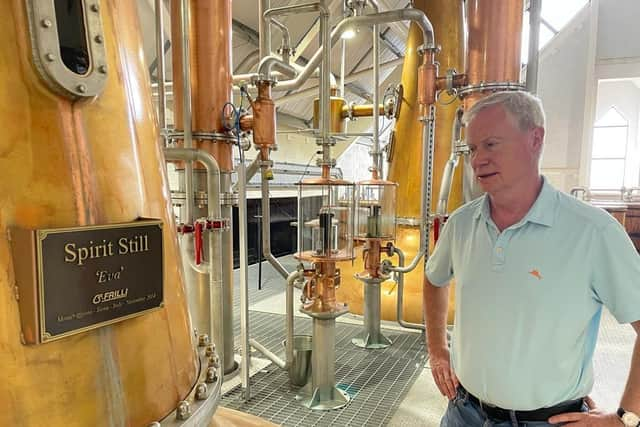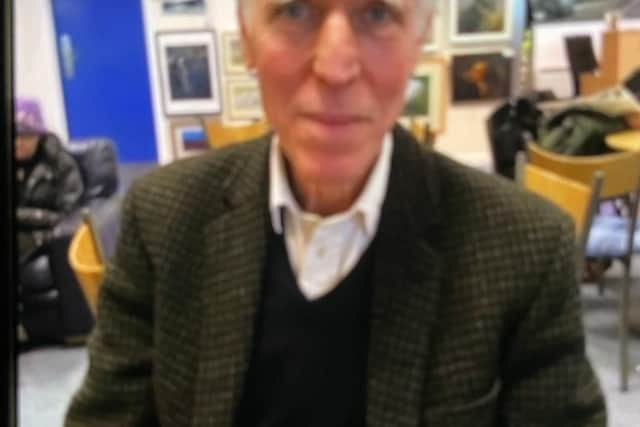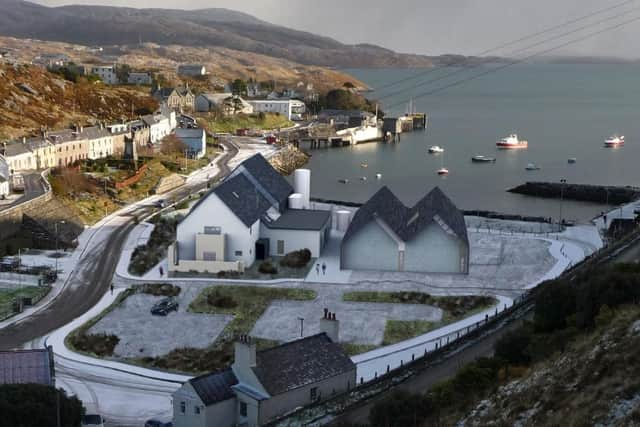Raising a glass to a long Harris journey


In a crowded field of Scotland’s recent distilleries, Harris has managed to make itself stand out as a master of marketing. This launch is no exception. The roll on the drums – or casks – leading to a Single Malt has been building towards a crescendo for years.
Shona Macleod, one of the “Tarbert Ten” who have been there from the start, says the great moment comes as a relief: “We have been asked, on the island and from all around the world, every day of our lives – when is the whisky going to be ready? We always answered that ‘it will be ready when it is ready’. Now we are able to name the day”.
Advertisement
Advertisement
The fabled Isle of Harris Gin, which the distillery has been producing since 2017, proved such a success that any time pressure to push ahead with a whisky release evaporated. However, Shona is in no doubt: “Whisky is the product which will secure the business in the long term”.


Anderson “Burr” Bakewell, originator of the whole venture, makes the same point about next week’s launch: “This is what it’s about. I like gin but this is what we were built for”.
Shona is the distillery’s guest services manager and over the past few years has added “distillery blender” to her job description. She left the island to graduate in hospitality management, spent 15 years away and, on returning, found the dream job on her doorstep. Since then, she has acquired a whole new set of skills.
It is an example of how the project has opened up career paths for islanders and allowed them to stay on the island to acquire skills which, if and when they choose, will be marketable wherever they go. There are now over 50 employees, the great majority recruited locally.
Advertisement
Advertisement
Now ‘The Hearach” is finally ready to go, the first iteration will consist of just 1916 bottles pre-purchased by individuals whose names are enshrined on the distillery’s wall of staves. Seven limited volume batches are also being produced.


The number 1916 has its own significance in the distillery’s raison d’etre. In the 2011 census, the population of Harris was 1916 and falling. In 1951 it had been 3991; in 1981, it was 2879. The fall was precipitous and various plans to arrest it – including the Lingerabay quarry development - had produced nothing but broken hopes.
An American musicologist and man of independent means, Burr Bakewell’s connection with Harris dated back to the 1960s when he arrived as a guest of his friend, the late Andrew Miller Mundy, whose family owned Amhuinnsuidhe estate. In particular, this started a love affair with Scarp of which Burr eventually became landlord in 1995 after a bizarre series of ownership changes and grand plans which came to nothing.
By then, Scarp had no resident population. Burr found it a place of solitude but was also aware of the decline Harris had suffered. Latterly, he wanted to put something back into the island that would prove sustainable and create employment. The distillery epiphany, he recalls, had been prompted by drinking the pure water from a burn above Bunabhainneadar and thinking “this would make a really nice whisky”.
Advertisement
Advertisement
Harris apart, Burr Bakewell had an interesting back-story. He grew up in St Louis which he describes as “the home of great music, some of the best really, which offered my first exposure to non-European music”. This led him into 25 years of “trying to save the world’s music, with some minor successes”. Yemen and its neighbourhood was his particular interest.


Variety was in his family background. An uncle, also Anderson Bakewell, combined being a Jesuit priest with discovering a new species of reptile in Mexico, scaling previously unscaled heights in the Yukon and being part of the first flight to circumnavigate the North and South Poles. Burr lived with him in Alaska for a few, doubtless character-building, years.
Like his uncle, he was a man who needed a project. In the 1990s, while visiting Madagascar, he was trying to reach a remote coastal village but heavy rains had washed away the road. His thoughts turned to how useful it would be to have a boat, not just any boat but a traditional ocean-going dhow of a kind that had not been built for half a century.
To cut a long story short, Burr eventually found the ancient skills in a place close to the India-Pakistan border. According to an account of this project, “work started in January 2000, with a team of 25 Indian boat-builders and a total of 138 tons of wood hauled to the beach with trains of oxen”. The result was an ocean-going dhow, Sanjeeda, which cruised commercially and in some considerable style until Burr sold it in 2006.
Advertisement
Advertisement
This opened the door to a project in Harris. He says: “The idea of a distillery had stayed at the back of my mind. I wondered why there had never been a distillery on Harris. As far back as Rev. John Buchanan’s ‘Travels in the Western Isles’ in the late 18th century, there was comment on the superior quality of the spirits, even from illicit stills. “I’m told we have ideal maritime conditions for maturation. Conditions are so different from the mainland and even Islay is exposed to different forces. We have the softest water in Scotland and atmospheric pressure which is very different even from the Inner Isles”. In short, he adds: “Some distilleries struggle with defining themselves and differentiating. We don’t have that problem”.
One might have thought that building a distillery would be straightforward after the Sanjeeda saga, but that did not prove to be the case. A site was identified – reclaimed land in Tarbert which had originally been earmarked for a Harris Tweed visitor centre that never came to fruition. However, fund-raising proved difficult, particularly once the global financial crisis of 2008 intervened. Burr says: “I had no idea it would take so long to raise the money”.
The executive chairman of Isle of Harris Distillers Ltd, Ron MacEachran, takes up the story. He had an industry background as chief financial officer with Whyte and Mackay and was taking a break when approached by a head-hunter in 2011 “about this strange project”.
Ron explains: “By then Burr had been at it for four years and this was him giving it one last try. I met him in London and was fascinated by the concept he described. Around the same time, he met Simon Erlanger (formerly Glenmorangie sales and marketing director), and we both decided to give it a go. My initial job was to oversee the fund raising and construction. Simon became managing director”.
Advertisement
Advertisement
For Ron, there was an additional attraction to the project though it was entirely coincidental. His mother, Mary Macleod, was from Scalpay and had left to train as a nurse. From earliest childhood, Ron was taken on holidays to what is still the family home above the harbour on Scalpay. Burr Bakewell says: “The Harris connection was a bonus when I met him”.
Finding investors who shared the vision and were not looking for rapid returns proved to be a three year roller coaster. A turning point came in December 2012 when the project secured a £1.9 million EU grant; the largest ever for a food and drink business in Scotland. This attracted attention from the Financial Times and the kind of glowing article which a journalistic excursion to Harris is pretty much guaranteed to secure. It was read by a wealthy widow sitting in the west of Ireland, Eva Tenback-Biesta.
Ron recalls: “Her financial adviser happened to be with her and she asked him to make inquiries. This led to a meeting in London with Burr, Simon and myself. She was an elegant lady, experienced in managing a substantial family business, who asked all sorts of incisive questions. The outcome was an investment of £1 million”.
Eva visited Harris and “really bought into it” but then she died from cancer in early 2014. “After the initial shock over such sad and unexpected news, we wondered what this would do to the project but within a few days were assured she had arranged her affairs so that there would be a seamless transfer to her niece”. This critical investment was secure – and explains why the spirit still in Harris Distillery is named “Eva” in her memory.
Advertisement
Advertisement
The long gestation period allowed stocks to build and three large bonded warehouses have been constructed in Ardhasaig. No matter the demand, this helps to guarantee that there will always be supplies of ‘The Hearach’ to meet it as well as, hopefully, a growing number of Hearachs available to produce it, market it and welcome the distillery visitors.
There are 18 investors in the Isle of Harris Distillery and most of them will be there for the launch. The board includes a major investor and expat-Scot, Hugh Grant, originally from Larkhall and until 2018, the president and chief executive of Monsanto. Scottish Enterprise invested early and, says Ron, “has shown a great level of support over the years”.
Burr Bakewell says: “The meetings with people looking for short-term returns were very brief. We have individuals who wanted to hand something down to their children or grand-children. They know that most distilleries were built in Victorian times, so this is a business that lasts. That is what appealed to them and most have become very interested in each stage of progress”.
Whereas quite a few recent distilleries have used gin production to bridge the financial gap for a few years until the whisky matures, none has had the same success as Harris in turning its gin into a prestige product on its own account. Part of the secret was to “market scarcity”; in other words, the product became desirable by being available through only very limited outlets, controlled by the distillery. Gradually, that net widened.
Advertisement
Advertisement
A second big selling point was the bottle which was designed by the London-based branding agency, Stranger & Stranger, who succeeded in creating a collectible thing of beauty which fitted the maritime image of Harris Gin. Shona Macleod says they could not have got it so right, without having come to the island and soaked up its colours and characteristics.
Sugar-kelp, dived for by Lewis Mackenzie in local waters, was hit upon as the added ingredient which gave the gin its distinctive, maritime taste. Shona Macleod says that people tend to “buy the gin the first time for the bottle, then buy it again and again because they like the gin”. Stranger & Stranger also designed the whisky bottles and packaging years ago, though these have manged to stay as safely guarded secrets to be unveiled along with the contents next week.
Nobody doubts that the whisky will follow the same successful trail. Burr Bakewell is one of the few who has had an advance taste. “I’m not really a big whisky drinker”, he says, “but someone who really does know about these things described it as ‘utterly delicious’, so I can’t really top that”.
Behind the profile the launch will attract, he recalls the social purpose that drove the vision: “Harris needed a big project to make an impact on employment and to help arrest depopulation. We were hoping for 20 people. I think everyone is so gratified by how it has developed so far”.